The Effect of Diagenetic Modifications on Porosity Development in the Upper Ordovician to Lower Silurian Wufeng and Longmaxi Formations, Southeast Sichuan Basin, China
Abstract
:1. Introduction
2. Geological Setting
3. Samples and Analytical Methods
4. Results
4.1. TOC Content and Ro
4.2. Mineralogy and Lithofacies
4.2.1. Siliceous Shale
4.2.2. Siliceous–Argillaceous Mixed Shale
4.2.3. Argillaceous Shale
4.3. Pore Types
4.4. Pore Structure Characteristics
4.5. Pore System after Combustion
4.5.1. Pore Types
4.5.2. Pore Volume and Specific Surface Area
4.6. Diagenetic Events
4.6.1. Compaction and Cementation
4.6.2. Dissolution and Clay Mineral Transformation
4.6.3. Thermal Evolution of Organic Matter
5. Discussion
5.1. Factors Controlling Pore Development in Different Lithofacies
5.1.1. TOC Content
5.1.2. Mineral Composition
5.2. Diagenetic Sequences
5.2.1. The Early Diagenetic Stages
5.2.2. The Middle Diagenetic Stages
5.2.3. The Late Diagenetic Stages
5.3. Pore Evolution Models of Different Lithofacies
5.3.1. Siliceous Shale
5.3.2. Siliceous–Argillaceous Mixed Shale
5.3.3. Argillaceous Shale
6. Conclusions
- (1).
- Three major lithofacies were identified in the WF-LMX formations, including siliceous shales, siliceous–argillaceous mixed shales, and argillaceous shales. Compared to other lithofacies, siliceous shales have relatively high TOC and quartz contents.
- (2).
- Four types of pores can be identified in the WF-LMX shales, mainly including organic pores, interparticle pores, and intraparticle pores and fractures; the organic pore is dominant pore type. There are significant differences in pore development among different lithofacies. The pore volume and surface area of micropores, mesopores, and macropores of siliceous shales are larger than those of siliceous–argillaceous mixed and argillaceous shales. Organic matter combustion experiments showed that micropores and mesopores are largely contributed by organic pores, while macropores may be contributed by both organic and inorganic pores.
- (3).
- Early diagenesis was characterized by compaction, pyrite precipitation, and authigenic quartz cementation. Compaction was the main factor driving declined porosity. The thermal degradation of organic matter, transformation of clay minerals, and dissolution of carbonate minerals were the dominant processes in middle diagenesis. The secondary cracking of residual organic matter was the main diagenetic event in late diagenesis. They together controlled the collapse of primary pores and generation of secondary pores, leading to shale reservoir quality.
- (4).
- The siliceous shale is characterized by high TOC and biogenic silica contents. During the early and middle diagenetic stages, recrystallization of biogenic silica can form a rigid framework that is resistant to overlying mechanical compaction. The generated oil and bitumen from organic matter maturation filled into pore spaces between microcrystalline quartz crystals can produce numerous organic pores through thermal cracking at the gas window. Thus, the porosity of siliceous shale is well developed, which is also of great significance for later development. On the contrary, the argillaceous shale is characterized by low TOC and high clay content. The primary pore space of argillaceous shales is greatly reduced under mechanical compaction simply due to the plastic behavior of clays.
Author Contributions
Funding
Institutional Review Board Statement
Informed Consent Statement
Data Availability Statement
Conflicts of Interest
References
- Nie, H.; Li, P.; Dang, W.; Ding, J.; Sun, X.; Liu, M.; Wang, J.; Du, W.; Zhang, P.; Li, D.; et al. Enrichment characteristics and exploration directions of deep shale gas of Ordovician Silurian in the Sichuan Basin and its surrounding areas, China. Petrol. Explor. Dev. 2022, 49, 648–659. [Google Scholar] [CrossRef]
- Zou, C.; Dong, D.; Wang, S.; Li, J.; Li, X.; Wang, Y.; Li, D.; Cheng, K. Geological characteristics and resource potential of shale gas in China. Petrol. Explor. Dev. 2010, 37, 641–653. [Google Scholar] [CrossRef]
- Guo, X.; Teng, G.; Wei, X.; Yu, L.; Lu, X.; Sun, L.; Wei, F. Occurrence mechanism and exploration potential of deep marine shale gas in Sichuan Basin. Acta Pet. Sin. 2022, 43, 453–468. [Google Scholar]
- Zhao, J.; Jin, Z.; Jin, Z.; Hu, Q.; Hu, Z.; Du, W.; Yan, C.; Geng, Y. Mineral types and organic matters of the Ordovician-Silurian Wufeng and Longmaxi Shale in the Sichuan Basin, China: Implications for pore systems, diagenetic pathways, and reservoir quality in fine-grained sedimentary rocks. Mar. Pet. Geol. 2017, 86, 655–674. [Google Scholar] [CrossRef]
- Dong, T.; He, S.; Chen, M.; Hou, Y.; Guo, X.; Wei, C.; Han, Y.; Yang, R. Quartz types and origins in the paleozoic Wufeng-Longmaxi Formations, Eastern Sichuan Basin, China: Implications for porosity preservation in shale reservoirs. Mar. Petrol. Geol. 2019, 106, 62–73. [Google Scholar] [CrossRef]
- Chalmers, G.R.L.; Bustin, R.M.; Power, I.M. Characterization of gas shale pore systems by porosimetry, pycnometry, surface area, and field emission scanning electron microscopy/transmission electron microscopy image analyses: Examples from the Barnett, Woodford, Haynesville, Marcellus, and Doig units. AAPG Bull. 2012, 96, 1099–1119. [Google Scholar]
- Loucks, R.G.; Reed, R.M.; Ruppel, S.C.; Jarvie, D.M. Morphology, genesis, and distribution of nanometer-scale pores in siliceous mudstones of the Mississippian Barnett Shale. J. Sediment. Res. 2009, 79, 848–861. [Google Scholar] [CrossRef]
- Loucks, R.G.; Reed, R.M.; Ruppel, S.C.; Hammes, U. Spectrum of pore types and networks in mudrocks and a descriptive classification for matrix-related mudrock pores. AAPG (Am. Assoc. Pet. Geol.) Bull. 2012, 96, 1071–1098. [Google Scholar] [CrossRef]
- Katz, B.J.; Arango, I. Organic porosity: A geochemist’s view of the current state of understanding. Org. Geochem. 2018, 123, 1–16. [Google Scholar] [CrossRef]
- Fishman, N.S.; Hackley, P.C.; Lowers, H.A.; Hill, R.J.; Egenhoff, S.O.; Eberl, D.D.; Blum, A.E. The nature of porosity in organic-rich mudstones of the Upper Jurassic Kimmeridge Clay Formation, North Sea, offshore United Kingdom. Int. J. Coal Geol. 2012, 103, 32–50. [Google Scholar] [CrossRef]
- Milliken, K.L.; Esch, W.L.; Reed, R.M.; Zhang, T. Grain assemblages and strong diagenetic overprinting in siliceous mudrocks, Barnett Shale (Mississippian), Fort Worth Basin, Texas. AAPG Bull. 2012, 96, 1553–1578. [Google Scholar] [CrossRef]
- Milliken, K.L.; Rudnicki, M.; Awwiller, D.N.; Zhang, T. Organic matter-hosted pore system, Marcellus Formation (Devonian), Pennsylvania. AAPG Bull. 2013, 97, 177–200. [Google Scholar] [CrossRef]
- Pommer, M.; Milliken, K.L. Pore types and pore-size distributions across thermal maturity, Eagle Ford Formation, southern Texas. AAPG Bull. 2015, 99, 1713–1744. [Google Scholar] [CrossRef]
- Dewhurst, D.N.; Aplin, A.C.; Sarda, J.P.; Yang, Y. Compaction-driven evolution of porosity and permeability in natural mudstones: An experimental study. J. Geophys. Res. 1998, 103, 651–661. [Google Scholar] [CrossRef]
- Mastalerz, M.; Hampton, L.; Drobniak, A.; Loope, H. Significance of analytical particle size in low-pressure N2 and CO2 adsorption of coal and shale. Int. J. Coal Geol. 2017, 178, 122–131. [Google Scholar] [CrossRef]
- Liu, S.; Yang, Y.; Deng, B.; Zhong, Y.; Wen, L.; Sun, W.; Li, Z.; Jansa, L.; Li, j.; Song, J.; et al. Tectonic evolution of the Sichuan Basin, Southwest China. Earth Sci. Rev. 2021, 213, 1–18. [Google Scholar] [CrossRef]
- Wang, Q.; Wang, T.; Liu, W.; Zhang, J.; Feng, Q.; Lu, H.; Peng, P.A. Relationships among composition, porosity and permeability of Longmaxi Shale reservoir in the Weiyuan Block, Sichuan Basin, China. Mar. Pet. Geol. 2019, 102, 33–47. [Google Scholar] [CrossRef]
- Karayigit, A.I.; Oskay, R.G.; Bulut, Y.; Mastalerz, M. Meso- and microporosity characteristics of Miocene lignite and subbituminous coals in the Kınık coalfield (Soma Basin, W. Turkey). Int. J. Coal Geol. 2020, 232, 103624. [Google Scholar] [CrossRef]
- Wang, R.; Hu, Z.; Bao, H.; Wu, J.; Du, W.; Wang, P.; Peng, Z.; Lu, T. Diagenetic evolution of key minerals and its controls on reservoir quality of Upper Ordovician Wufeng-Lower Silurian Longmaxi shale of Sichuan Basin. Petrol. Geol. Exper. 2021, 6, 996–1005. [Google Scholar]
- Dai, J.; Zou, C.; Liao, S.; Dong, D.; Ni, Y.; Huang, J.; Wu, W.; Gong, D.; Huang, S.; Hu, G. Geochemistry of the extremely high thermal maturity Longmaxi shale gas, southern Sichuan Basin. Org. Geochem. 2014, 74, 3–12. [Google Scholar] [CrossRef]
- Fan, C.; Li, H.; Zhong, C.; Qin, Q.; Hu, D.; Zhang, Y.; He, S.; Zhang, W. Tectonic fracture stages and evolution model of Longmaxi Formation shale, Dingshan structure, Southeast Sichuan. Acta Pet. Sin. 2018, 39, 379–390. [Google Scholar]
- Lu, Z.; He, Z.; Yu, C.; Ye, X.; Li, H.; Du, W.; Nie, H. The structural features are mainly composed of high steep anticlinal zone and fault zone, which are composed of barrier and preitetrough folds, and arranged in parallel. Oil Gas Geol. 2021, 42, 86–97. [Google Scholar]
- Zou, C.; Zhu, R.; Chen, Z.; Ogg, J.; Wu, S.; Dong, D.; Qiu, Z.; Wang, Y.; Wang, L.; Lin, S.; et al. Organic-matter-rich shales of China. Earth Sci. Rev. 2019, 189, 104134. [Google Scholar] [CrossRef]
- Liu, Z.; Algeo, T.J.; Guo, X.; Fan, J.; Du, X.; Lu, Y. Paleo-environmental cyclicity in the Early Silurian Yangtze Sea (South China): Tectonic or glacio-eustatic control? Palaeogeogr. Palaeoclimatol. Palaeoecol. 2017, 466, 59–76. [Google Scholar] [CrossRef]
- Lu, Y.; Jiang, S.; Lu, Y.; Xu, S.; Shu, Y.; Wang, Y. Productivity or preservation? The factors controlling the organic matter accumulation in the late Katian through Hirnantian Wufeng organic-rich shale, South China. Mar. Petrol. Geol. 2019, 109, 22–35. [Google Scholar] [CrossRef]
- Chen, X.; Fan, J.; Melchin, M.; Mitchell, C. Hirnantian (Latest Ordovician) graptolites from the upper Yangtze region, China. Palaeontology 2005, 48, 235–280. [Google Scholar]
- Chen, X.; Rong, J.; Fan, J.; Zhan, R.; Mitchell, C.; Harper, D.; Melchin, M.; Peng, P.; Finney, S.; Wang, X. The global boundary stratotype Section and point (GSSP) for the base of the Hirnantian Stage (the uppermost of the Ordovician System). Episodes 2006, 29, 183–196. [Google Scholar] [CrossRef]
- Li, Y.; Wang, X.; Wu, B.; Li, G.; Wang, D. Sedimentary facies of marine shale gas formations in Southern China: The Lower Silurian Longmaxi Formation in the southern Sichuan Basin. J. Earth Sci. 2016, 27, 807–822. [Google Scholar] [CrossRef]
- Ravikovitch, P.I.; Neimark, A.V. Density functional theory model of adsorption on amorphous and microporous silica materials. Langmuir 2006, 22, 10864–10868. [Google Scholar] [CrossRef]
- Barret, E.P.; Joyner, L.G.; Halenda, P.P. The determination of pore volume and area distribution in porous substances. I. Computations from nitrogen isotherms. J. Am. Chem. Soc. 1951, 73, 373–380. [Google Scholar] [CrossRef]
- Schieber, J. Common themes in the formation and preservation of intrinsic porosity in shales and mudstones-illustrated with examples across the Phanerozoic. In Proceedings of the SPE Unconventional Gas Conference, Pittsburgh, PA, USA, 23–25 February 2010. SPE 132370. [Google Scholar]
- Loucks, R.G.; Reed, R.M.; Ruppel, S.C. Mississippian Barnett Shale: Lithofacies and depositional setting of a deep-water shale-gas succession in the Fort Worth Basin, Texas. AAPG (Am. Assoc. Pet. Geol.) Bull. 2007, 91, 579–601. [Google Scholar] [CrossRef]
- Wang, G.C.; Carr, T.R. Methodology of organic-rich shale lithofacies identificationand prediction: A case study from Marcellus Shale in the Appalachian basin. Comput. Geosci. 2012, 49, 151–163. [Google Scholar] [CrossRef]
- Jia, A.; Hu, D.; He, S.; Guo, X.; Hou, Y.; Wang, T.; Yang, R. Variations of Pore Structure in Organic-Rich Shales with Different Lithofacies from the Jiangdong Block, Fuling Shale Gas Field, SW China: Insights into Gas Storage and Pore Evolution. Energy Fuels 2020, 34, 12457–12475. [Google Scholar] [CrossRef]
- Wang, C.; Dong, T.; Jiang, S.; Zhang, Y.; Yang, L.; Liang, X.; Wang, G. Vertical heterogeneity and the main controlling factors of the Upper Ordovician-Lower Silurian Wufeng-Longmaxi shales in the Middle Yangtze Region. Bull. Geol. Sci. Technol. 2022, 41, 108–121. [Google Scholar]
- Reed, R.M.; Loucks, R.G. Imaging nanoscale pores in the Mississippian Barnett Shale of the northern Fort Worth Basin (abs.). AAPG Annu. Conv. Abstr. 2007, 16, 115. [Google Scholar]
- Sing, K.S.W.; Everett, D.H.; Haul, R.A.W.; Moscou, L.; Pierotti, R.A.; Rouquérol, J.; Siemieniewska, T. Reporting physisorption data for gas/solid systems with special reference to the determination of surface area and porosity. Pure Appl. Chem. 1985, 57, 603–619. [Google Scholar] [CrossRef]
- Wang, Y.; Zhu, Y.M.; Chen, S.B. Characteristics of the nanoscale pore structure in Northwestern Hunan shale gas reserviors using filed emission scanning electron microscopy, high-pressure mercury intrusion, and gas adsorption. Energy Fuels 2014, 28, 945–955. [Google Scholar] [CrossRef]
- Thommes, M.; Kaneko, K.; Neimark, A.V.; Olivier, J.; Rodriguez-Reinoso, F.; Rouquerol, J.; Sing, K. Physisorption of gases, with special reference to the evaluation of surface area and pore size distribution (IUPAC Technical Report). Pure Appl. Chem. 2015, 87, 1051–1069. [Google Scholar] [CrossRef]
- Milliken, K.L.; Ergene, S.M.; Ozka, A. Quartz types, authigenic and detrital, in the upper cretaceous eagle ford formation, south Texas, USA. Sediment. Geol. 2016, 339, 273–288. [Google Scholar] [CrossRef]
- Ji, W.; Hao, F.; Schulz, H.M.; Song, Y.; Tian, J. The architecture of organic matter and its pores in highly mature gas shales of the lower Silurian Longmaxi Formation in the upper Yangtze platform, south China. AAPG Bull. 2019, 103, 2909–2942. [Google Scholar] [CrossRef]
- Löhr, S.C.; Baruch, E.T.; Hall, P.A.; Kennedy, M.J. Is organic pore development in gas shales influenced by the primary porosity and structure of thermally immature organic matter. Org. Geochem. 2015, 87, 119–132. [Google Scholar] [CrossRef]
- Hower, J.; Eslinger, E.V.; Hower, M.E. Mechanism of burial metamorphism of argillaceous sediment: 1. Mineralogical and chemical evidence. GSA Bull. 1976, 87, 725–737. [Google Scholar] [CrossRef]
- Peltonen, C.; Marcussen, Ø.; Bjørlykke, K.; Jahren, J. Clay mineral diagenesis and quartz cementation in mudstones: The effects of smectite to illite reaction on rock properties. Mar. Petrol. Geol. 2009, 26, 887–898. [Google Scholar] [CrossRef]
- Huang, S.; Huang, K.; Feng, W.; Tong, H.; Liu, L.; Zhang, X. Mass exchanges among feldspar, kaolinite and illite and their influences on secondary porosity formation in clastic diagenesis–A case study on the Upper Paleozoic, Ordos Basin and Xujiahe Formation, Western Sichuan Depression. Geochemical 2009, 38, 498–506. [Google Scholar]
- Stixrude, L.; Peacor, D.R. First-principles study of illite-smectite and implications for clay mineral systems. Nature 2002, 420, 165–168. [Google Scholar] [CrossRef] [PubMed]
- Curtis, M.E.; Cardott, B.J.; Sondergeld, C.H.; Rai, C.S. Development of organic porosity in the Woodford Shale with increasing thermal maturity. Int. J. Coal Geol. 2012, 103, 26–31. [Google Scholar] [CrossRef]
- Chen, Z.; Song, Y.; Jiang, Z.; Liu, S.; Li, Z.; Shi, D.; Yang, W.; Yang, Y.; Song, J.; Gao, F.; et al. Identification of organic matter components and organic pore characteristics of marine shale: A case study of Wufeng-Longmaxi shale in southern Sichuan Basin, China. Mar. Pet. Geol. 2019, 109, 56–69. [Google Scholar] [CrossRef]
- Piane, C.D.; Ansari, H.; Li, Z.; Mata, J.; Rickard, W.; Pini, R.; Dewhurst, D.N.; Sherwood, N. Influence of organic matter type on porosity development in the Wufeng-Longmaxi Shale: A combined microscopy, neutron scattering and physisorption approach. Int. J. Coal Geol. 2022, 249, 103880. [Google Scholar] [CrossRef]
- Teng, J.; Liu, B.; Mastalera, M.; Schieber, J. Origin of organic matter and organic pores in the overmature Ordovician-Silurian Wufeng-Longmaxi Shale of the Sichuan Basin, China. Int. J. Coal Geol. 2022, 253, 103970. [Google Scholar] [CrossRef]
- Ross, D.J.K.; Bustin, R.M. The importance of shale composition and pore structure upon gas storage potential of shale gas reservoirs. Mar. Pet. Geol. 2009, 26, 916–927. [Google Scholar] [CrossRef]
- Liang, C.; Jiang, Z.; Yang, Y.; Wei, X. Shale lithofacies and reservoir space of the Wufeng- Longmaxi formation, Sichuan Basin, China. Pet. Explor. Dev. 2012, 39, 736–743. [Google Scholar] [CrossRef]
- Xiong, J.; Liu, X.; Liang, L. Experimental study on the pore structure characteristics of the Upper Ordovician Wufeng Formation shale in the southwest portion of the Sichuan Basin, China. J. Nat. Gas. Sci. Eng. 2015, 22, 530–539. [Google Scholar] [CrossRef]
- Guan, Q.; Dong, D.; Zhang, H.; Sun, S.; Zhang, S.; Guo, W. Types of biogenic quartz and its coupling storage mechanism in organic-rich shales: A case study of the Upper Ordovician Wufeng Formation to Lower Silurian Longmaxi Formation in the Sichuan Basin, SW China. Petrol. Explor. Dev. 2021, 48, 813–823. [Google Scholar] [CrossRef]
- Zhao, J.; Jin, Z.; Jin, Z.; Wen, X.; Geng, Y. Origin of authigenic quartz in organic rich shales of the Wufeng and Longmaxi Formations in the Sichuan Basin, South China: Implications for pore evolution. J. Nat. Gas Sci. Eng. 2017, 38, 21–38. [Google Scholar] [CrossRef]
- Xu, E.; Li, Z.; Yang, Z. Thermal and hydrocarbon generation history of Wufeng and Longmaxi shales in Pengshui area, eastern Sichuan Basin: A well PY1 case study. Exp. Petrol. Geol. 2015, 37, 494–499. [Google Scholar]
- Wilkin, R.; Barnes, H. Formation processes of framboidal pyrite. Geochim. Cosmochim. Acta 1997, 61, 323–339. [Google Scholar] [CrossRef]
- Roberts, A.P.; Turner, G.M. Diagenetic formation of ferrimagnetic iron sulphide minerals in rapidly deposited marine sediments, South Island, New Zealand. Earth Planet. Sci. Lett. 1993, 115, 257–273. [Google Scholar] [CrossRef]
- Aplin, A.C.; Macquaker, J.H.S. Mudstone diversity: Origin and implications for source, seal, and reservoir properties in petroleum systems. AAPG Bull. 2012, 95, 2031–2059. [Google Scholar] [CrossRef]
- Bjørlykke, K. Clay Mineral Diagenesis in Sedimentary Basins: A Key to the Prediction of Rock Properties, Examples from the North Sea Basin. Clay Miner. 1998, 33, 15–34. [Google Scholar] [CrossRef]
- Camp, W.K. Diagenetic evolution of organic matter cements: Implications for unconventional shale reservoir quality prediction. In Mudstone Diagenesis: Research Perspectives for Shale Hydrocarbon Reservoirs, Seals, and Source Rocks; Camp, W., Milliken, K., Taylor, K., Fishman, N., Hackley, P., Macquaker, J., Eds.; AAPG Memoir: Tulsa, OK, USA, 2019; Volume 120, pp. 209–224. [Google Scholar]
- Misch, D.; Gross, D.; Hawranek, G.; Horsfield, B.; Klaver, J.; Mendez-Martin, F.; Urai, J.L. Solid bitumen in shales: Petrographic characteristics and implications for reservoir characterization. Int. J. Coal Geol. 2019, 205, 14–31. [Google Scholar] [CrossRef]
- Wei, C.; Dong, T.; He, Z.; He, S.; He, Q.; Yang, R.; Guo, X.; Hou, Y. Major, trace-elemental and sedimentological characterization of the upper Ordovician Wufeng-lower Silurian Longmaxi formations, Sichuan Basin, south China: Insights into the effect of relative sea-level fluctuations on organic matter accumulation in shales. Mar. Petrol. Geol. 2021, 126, 104905. [Google Scholar] [CrossRef]
- Feng, Y.; Xiao, X.; Gao, P.; Wang, E.; Hu, D.; Liu, R.; Li, G.; Lu, C. Restoration of sedimentary environment and geochemical features of deep marine Longmaxi shale and its significance for shale gas: A case study of the Dingshan area in the Sichuan Basin, South China. Mar. Petrol. Geol. 2023, 151, 106186. [Google Scholar] [CrossRef]
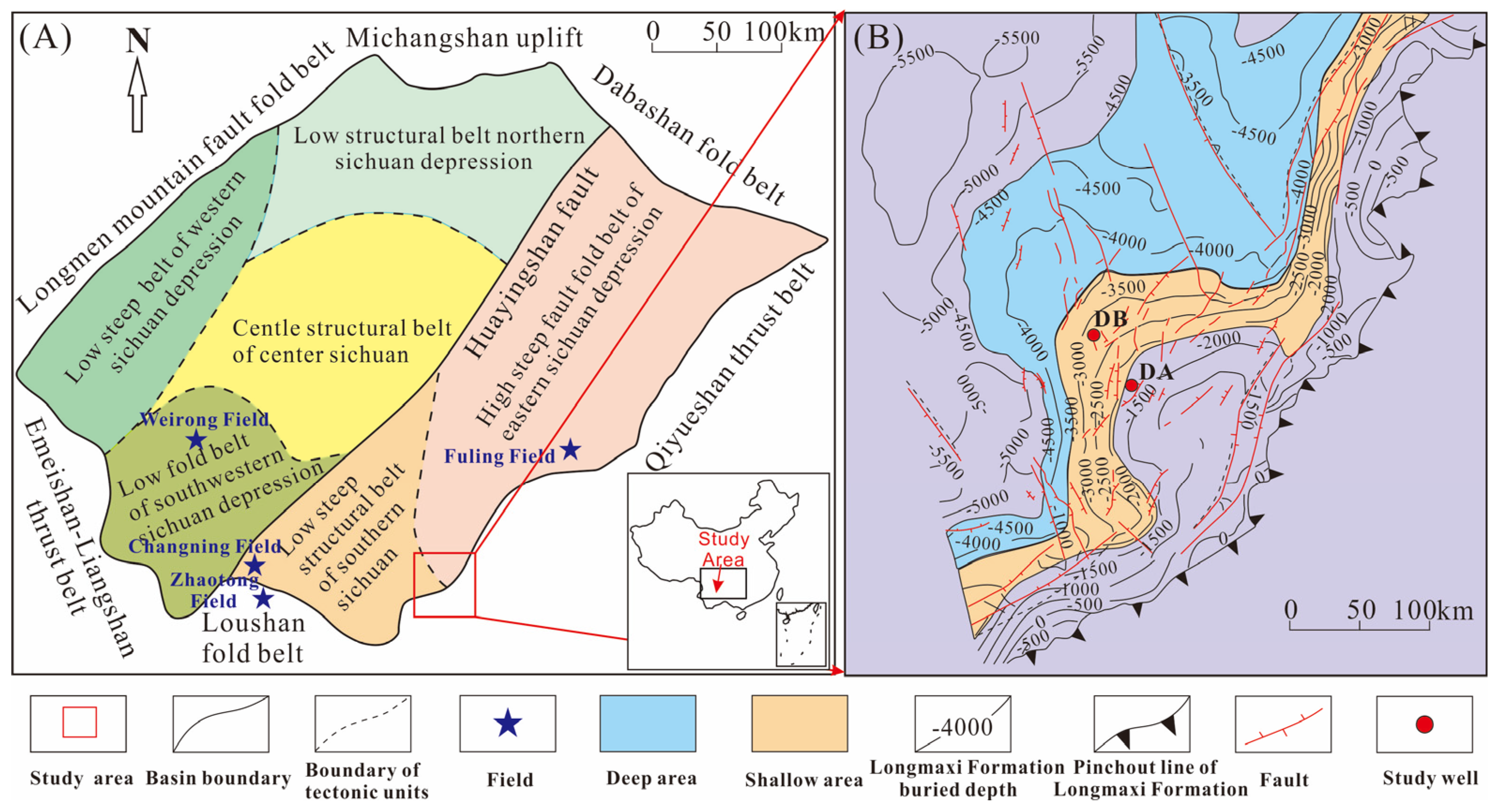
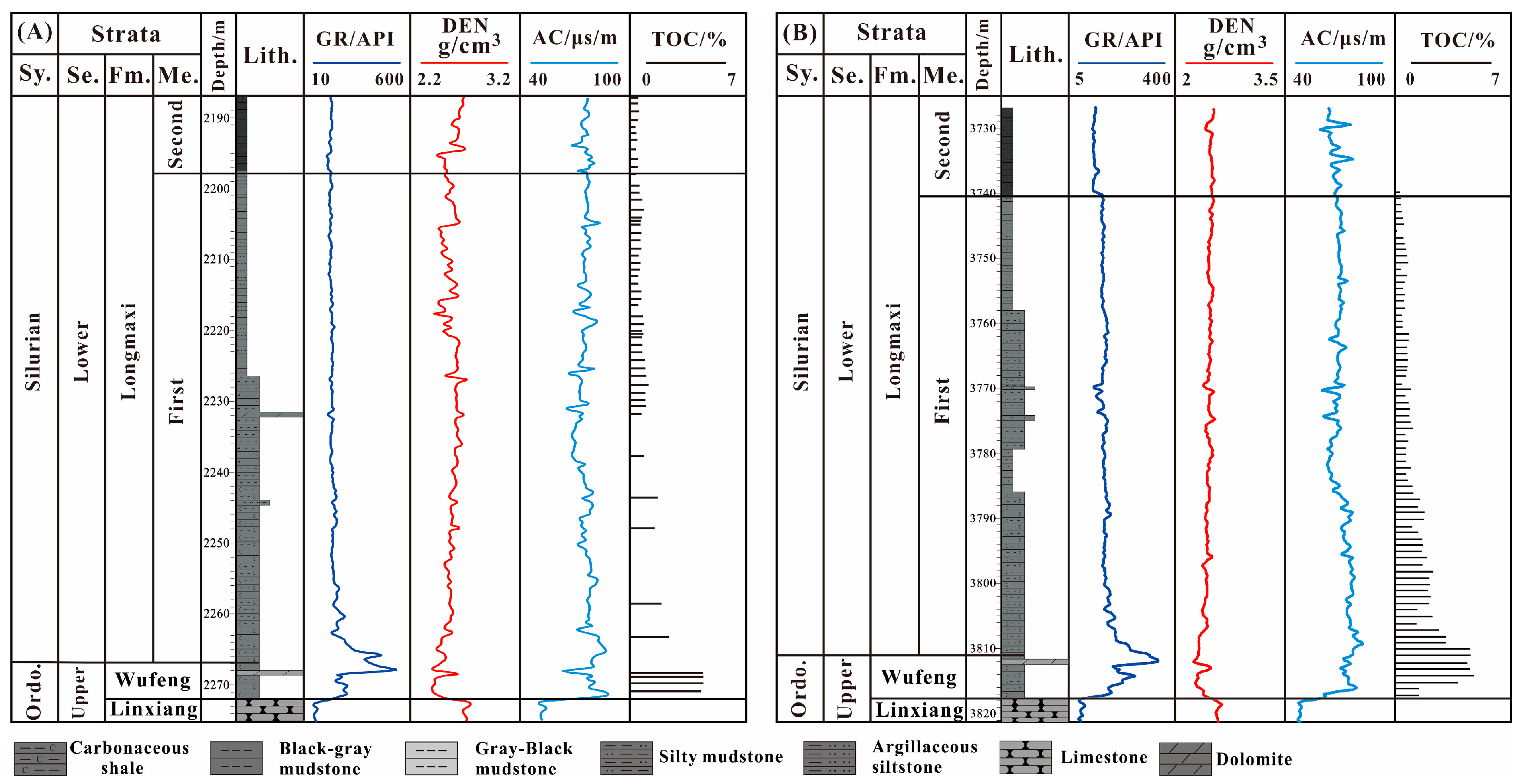
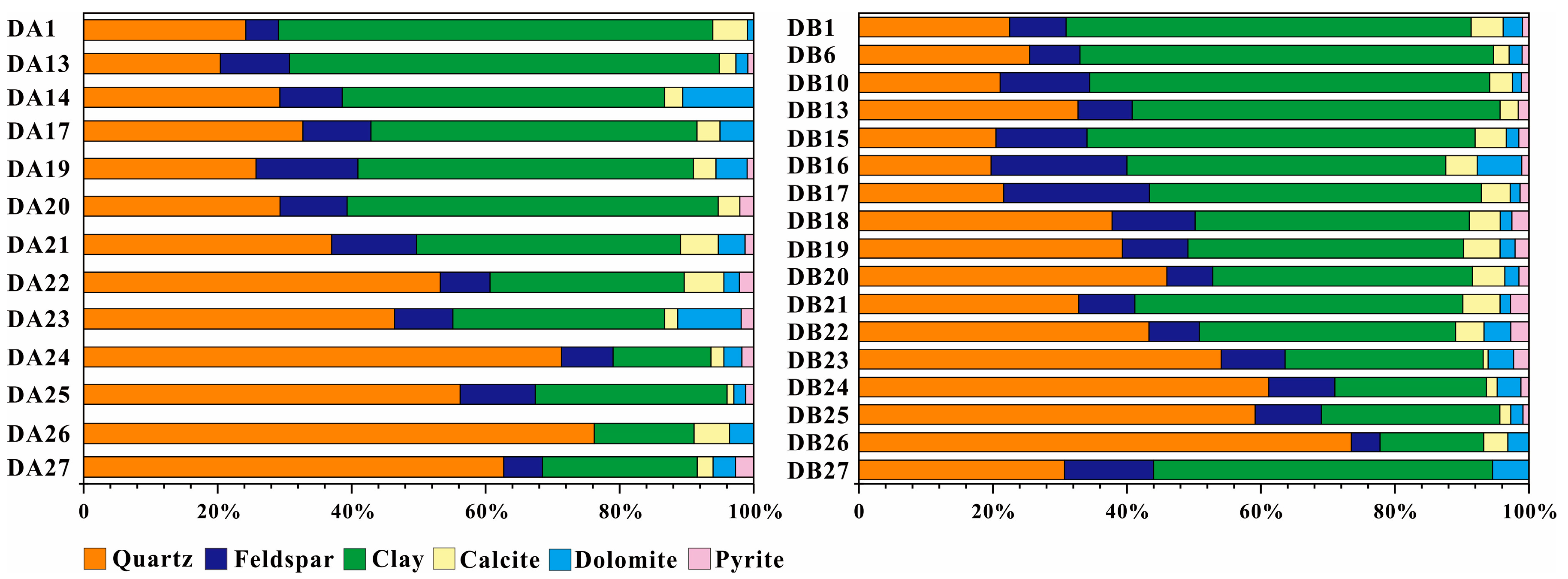
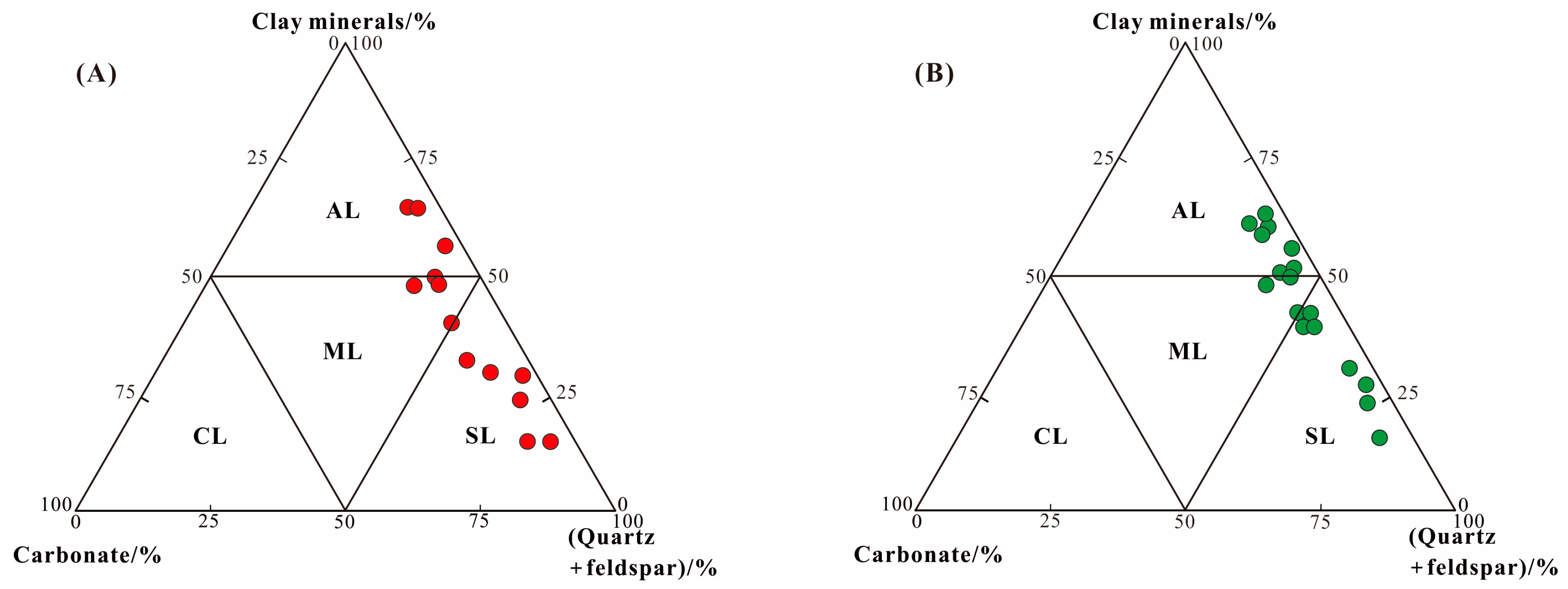
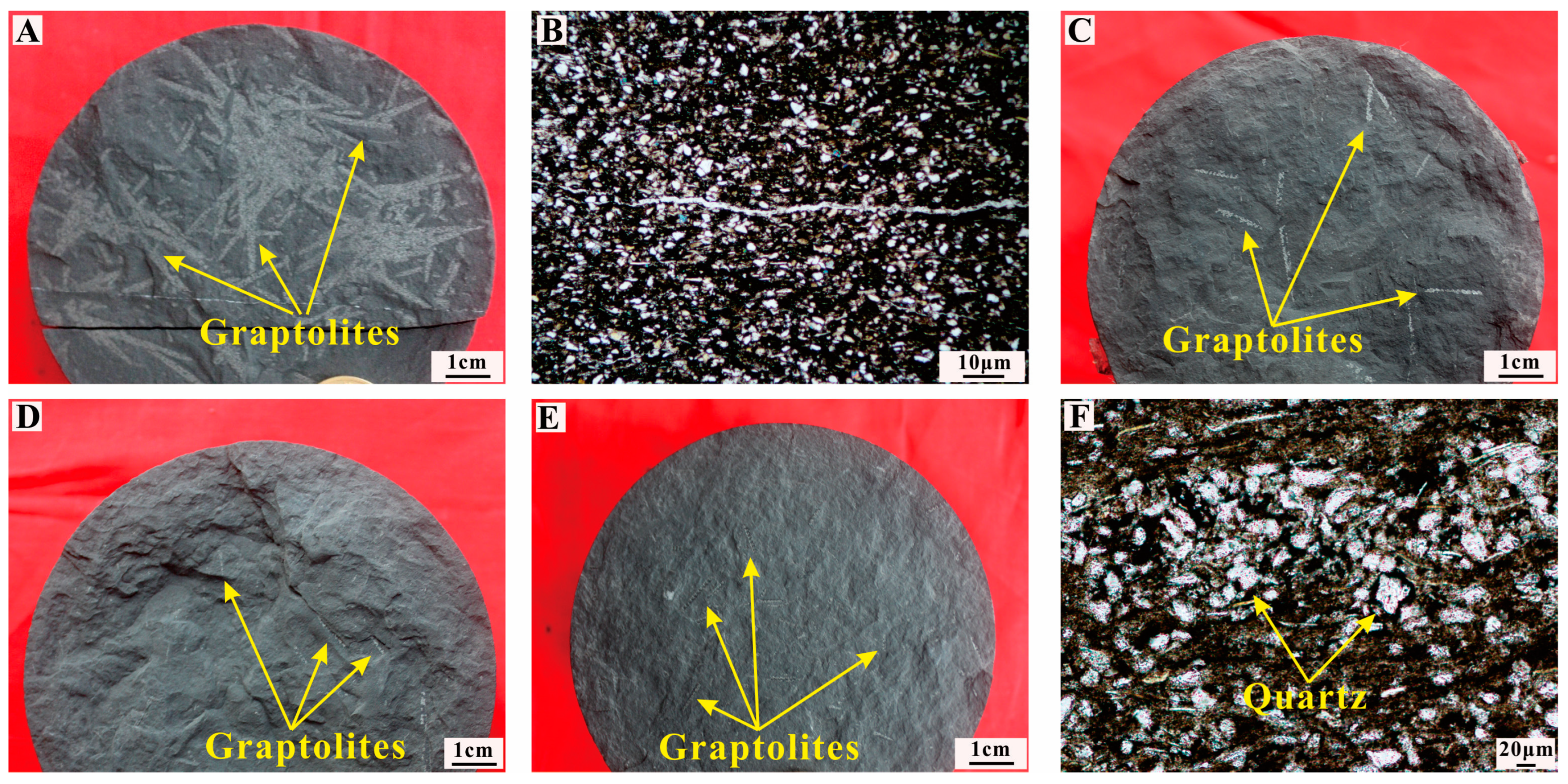





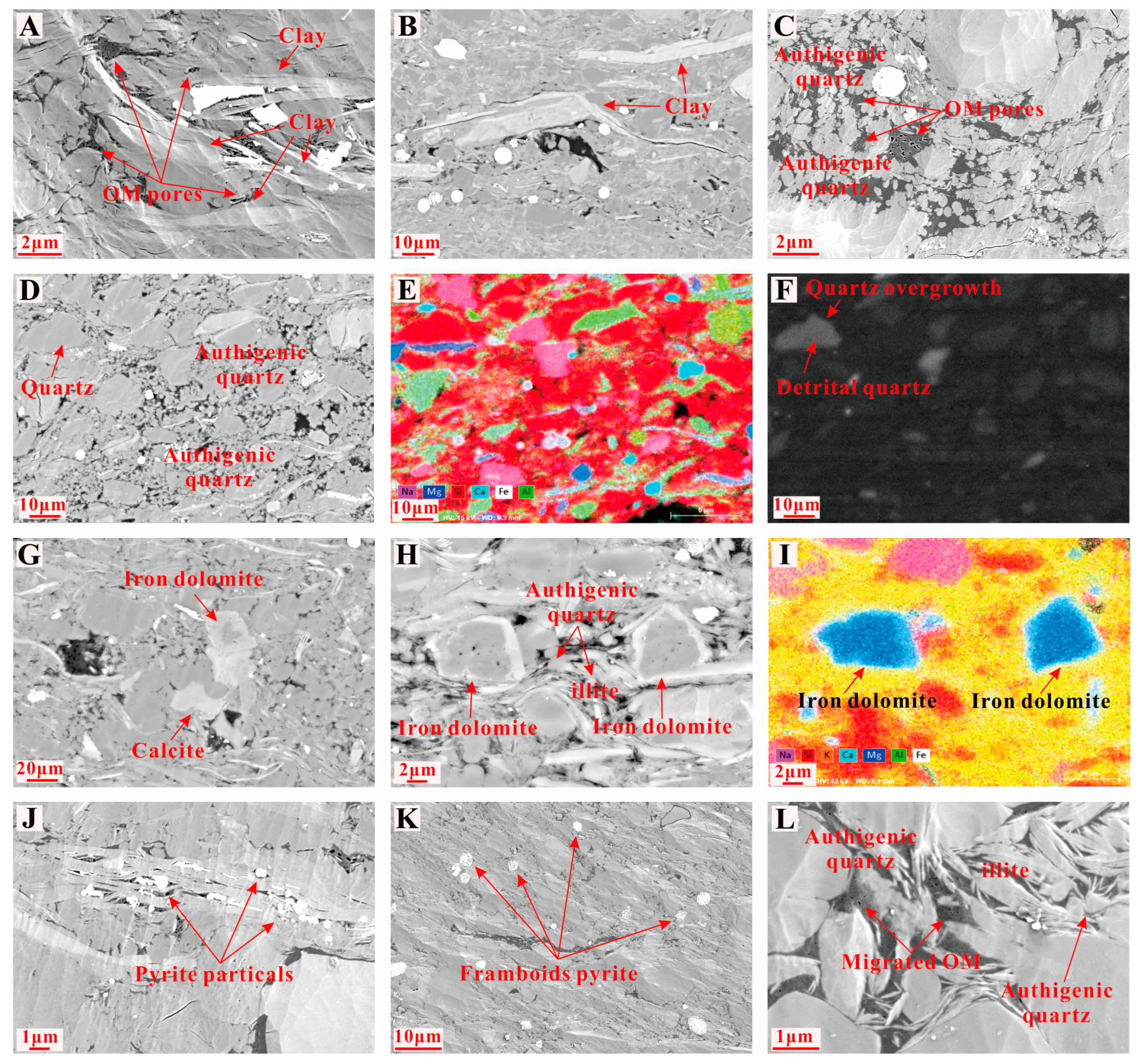
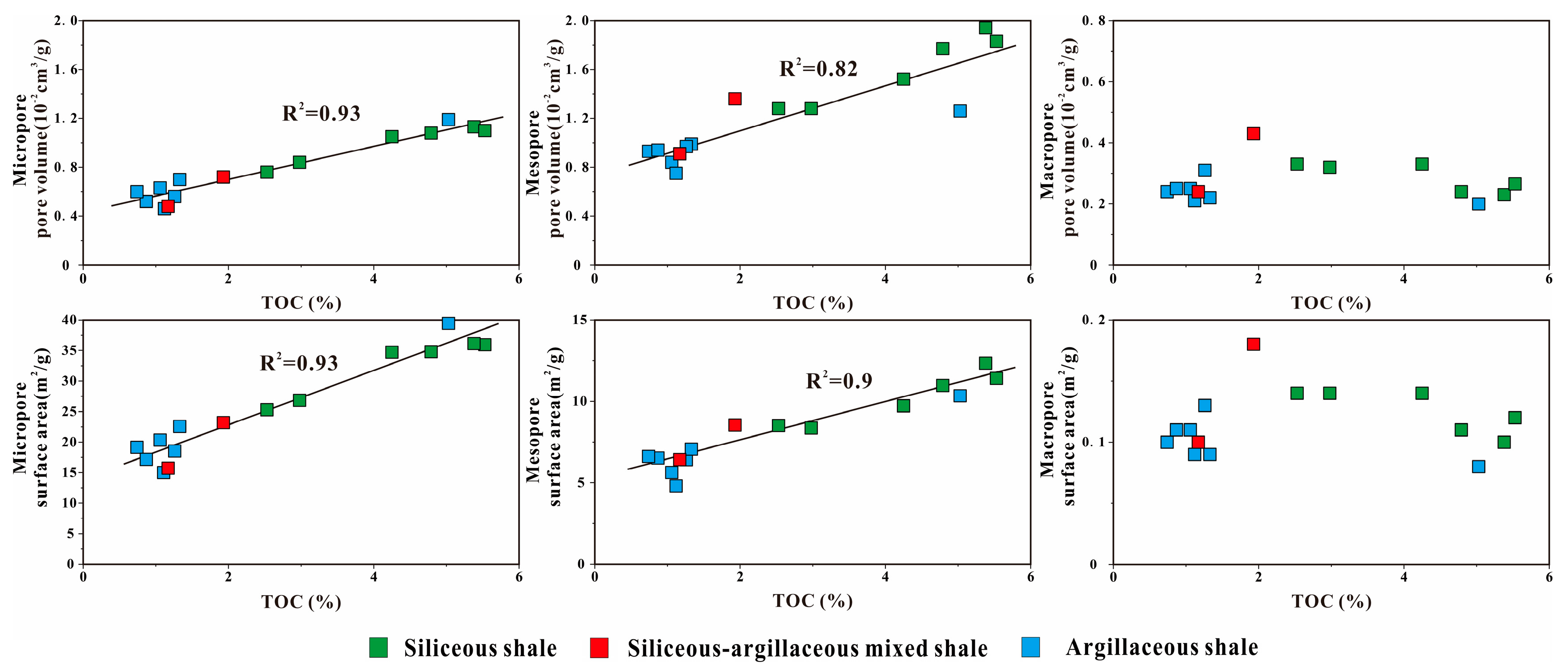
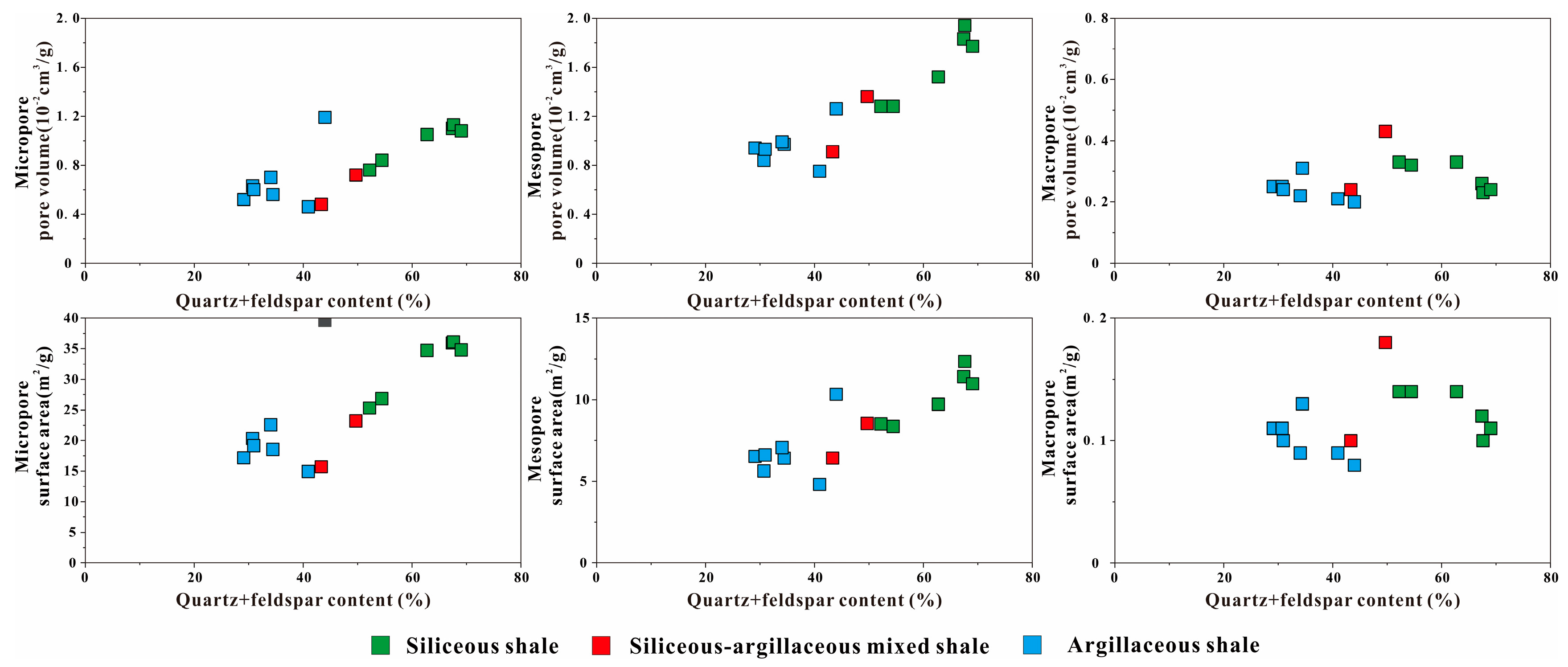
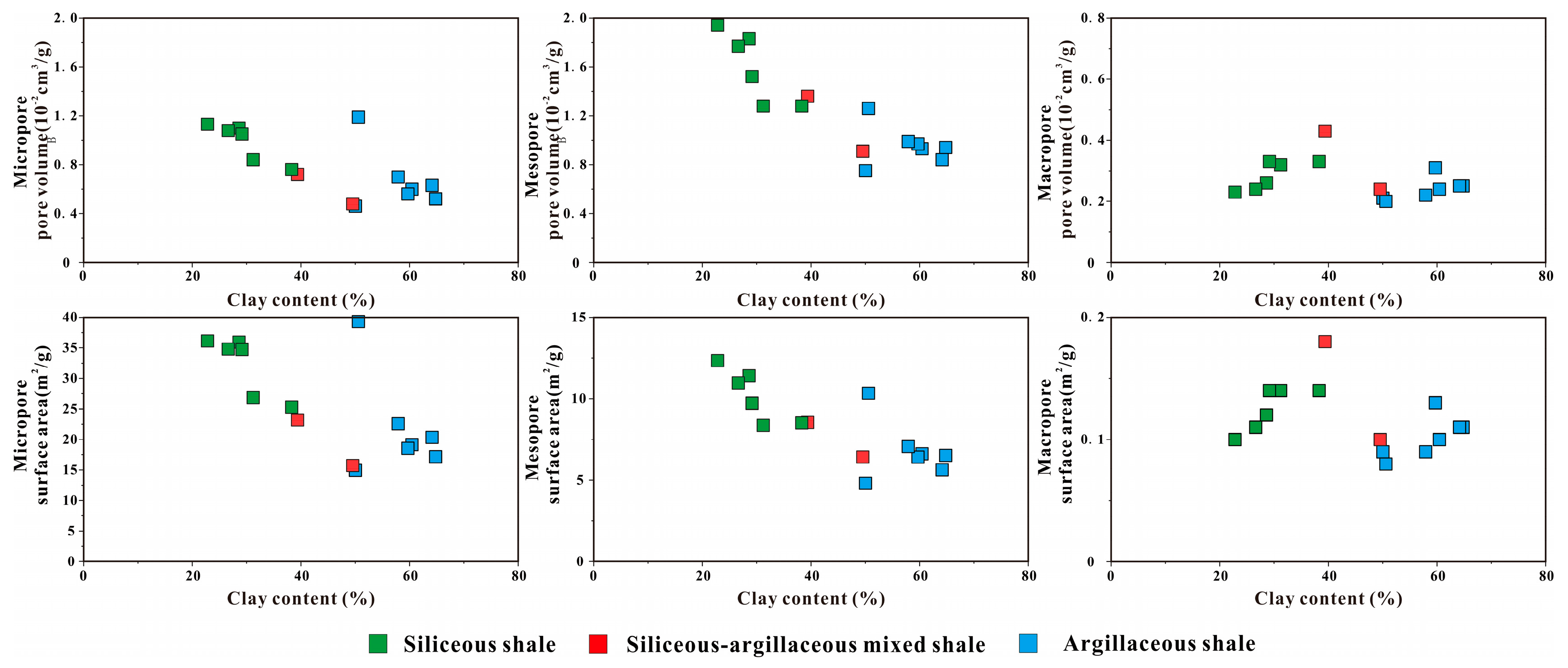
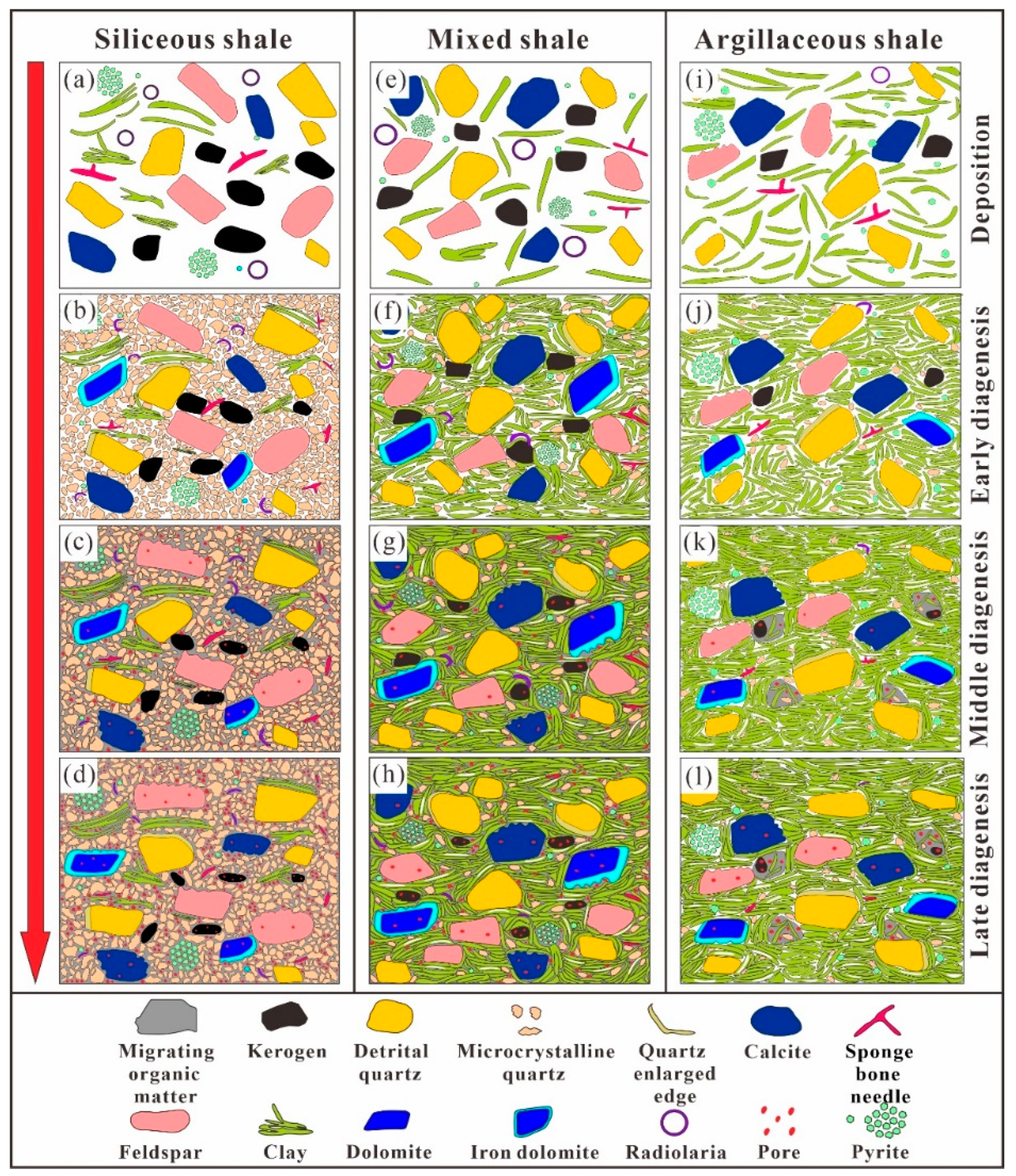
| Well Name | Sample No. | Formation | Depth (m) | TOC (wt.%) | Well Name | Sample No. | Formation | Depth (m) | TOC (wt.%) |
|---|---|---|---|---|---|---|---|---|---|
| DA | DA1 | Longmaxi | 2204.43 | 0.87 | DB | DB1 | Longmaxi | 3743.3 | 0.74 |
| DA | DA2 | Longmaxi | 2209.11 | 0.73 | DB | DB2 | Longmaxi | 3744.97 | 0.75 |
| DA | DA3 | Longmaxi | 2210.15 | 0.87 | DB | DB3 | Longmaxi | 3747.95 | 1.02 |
| DA | DA4 | Longmaxi | 2211.03 | 0.82 | DB | DB4 | Longmaxi | 3750.85 | 1.22 |
| DA | DA5 | Longmaxi | 2211.96 | 0.71 | DB | DB5 | Longmaxi | 3753.87 | 0.82 |
| DA | DA6 | Longmaxi | 2212.98 | 0.7 | DB | DB6 | Longmaxi | 3754.04 | 0.74 |
| DA | DA7 | Longmaxi | 2214.09 | 0.92 | DB | DB7 | Longmaxi | 3756.72 | 0.85 |
| DA | DA8 | Longmaxi | 2215.12 | 0.94 | DB | DB8 | Longmaxi | 3759.83 | 0.74 |
| DA | DA9 | Longmaxi | 2215.96 | 0.71 | DB | DB9 | Longmaxi | 3762.81 | 1.12 |
| DA | DA10 | Longmaxi | 2217.54 | 1.04 | DB | DB10 | Longmaxi | 3765.57 | 1.26 |
| DA | DA11 | Longmaxi | 2218.67 | 1.1 | DB | DB11 | Longmaxi | 3765.82 | 1.31 |
| DA | DA12 | Longmaxi | 2219.54 | 0.97 | DB | DB12 | Longmaxi | 3768.27 | 1.16 |
| DA | DA13 | Longmaxi | 2220.08 | 1.06 | DB | DB13 | Longmaxi | 3769.78 | 1.03 |
| DA | DA14 | Longmaxi | 2221.49 | 1.01 | DB | DB14 | Longmaxi | 3771.29 | 0.9 |
| DA | DA15 | Longmaxi | 2223.61 | 1.21 | DB | DB15 | Longmaxi | 3776.11 | 1.33 |
| DA | DA16 | Longmaxi | 2224.74 | 1.22 | DB | DB16 | Longmaxi | 3783.25 | 1.11 |
| DA | DA17 | Longmaxi | 2230.02 | 1.26 | DB | DB17 | Longmaxi | 3783.9 | 1.17 |
| DA | DA18 | Longmaxi | 2231.27 | 0.92 | DB | DB18 | Longmaxi | 3789.46 | 2.15 |
| DA | DA19 | Longmaxi | 2237.06 | 1.12 | DB | DB19 | Longmaxi | 3792.44 | 2.16 |
| DA | DA20 | Longmaxi | 2242.84 | 2.13 | DB | DB20 | Longmaxi | 3799.28 | 2.53 |
| DA | DA21 | Longmaxi | 2247.09 | 1.93 | DB | DB21 | Longmaxi | 3804.76 | 2.76 |
| DA | DA22 | Longmaxi | 2257.57 | 2.41 | DB | DB22 | Longmaxi | 3807.7 | 4.09 |
| DA | DA23 | Longmaxi | 2262.2 | 2.98 | DB | DB23 | Longmaxi | 3809.24 | 4.25 |
| DA | DA24 | Longmaxi | 2267.19 | 5.52 | DB | DB24 | Longmaxi | 3811.6 | 5.37 |
| DA | DA25 | Longmaxi | 2267.7 | 5.53 | DB | DB25 | Wufeng | 3812.4 | 4.79 |
| DA | DA26 | Wufeng | 2268.61 | 5.53 | DB | DB26 | Wufeng | 3815.26 | 4.71 |
| DA | DA27 | Wufeng | 2269.74 | 5.38 | DB | DB27 | Wufeng | 3817.27 | 5.03 |
| Well Name | Depth (m) | TOC (wt.%) | |
|---|---|---|---|
| Pre-Combustion | Post-Combustion | ||
| DA | 2247.09 | 1.93 | 0.07 |
| DA | 2262.2 | 2.98 | 0.08 |
| DA | 2267.7 | 5.53 | 0.08 |
| DA | 2269.74 | 5.38 | 0.09 |
| DB | 3743.3 | 0.74 | 0.08 |
| DB | 3754.04 | 1.26 | 0.07 |
| DB | 3776.11 | 1.33 | 0.07 |
| DB | 3783.9 | 1.17 | 0.08 |
| DB | 3799.28 | 2.53 | 0.08 |
| DB | 3809.24 | 4.25 | 0.07 |
| DB | 3812.4 | 4.79 | 0.08 |
| DB | 3817.27 | 5.03 | 0.08 |
| Lithofacies | Well Name | Depth (m) | Pore Volume (10−2 cm3/g) | Surface Area (m2/g) | Pore Volume (10−2 cm3/g) | Surface Area (m2/g) | ||||
|---|---|---|---|---|---|---|---|---|---|---|
| Micropore | Mesopore | Macropore | Micropore | Mesopore | Macropore | |||||
| Argillaceous shale | DA | 2204.43 | 1.71 | 23.79 | 0.52 | 0.94 | 0.25 | 17.16 | 6.52 | 0.11 |
| DA | 2220.08 | 1.72 | 26.07 | 0.63 | 0.84 | 0.25 | 20.33 | 5.63 | 0.11 | |
| DA | 2237.06 | 1.42 | 19.82 | 0.46 | 0.75 | 0.21 | 14.93 | 4.8 | 0.09 | |
| DB | 3743.3 | 1.77 | 25.87 | 0.6 | 0.93 | 0.24 | 19.15 | 6.62 | 0.1 | |
| DB | 3754.04 | 1.84 | 25.07 | 0.56 | 0.97 | 0.31 | 18.53 | 6.41 | 0.13 | |
| DB | 3776.11 | 1.91 | 29.7 | 0.7 | 0.99 | 0.22 | 22.55 | 7.06 | 0.09 | |
| DB | 3817.27 | 2.65 | 50.06 | 1.19 | 1.26 | 0.2 | 39.64 | 10.34 | 0.08 | |
| Siliceous–argillaceous mixed shale | DB | 3783.9 | 1.63 | 22.25 | 0.48 | 0.91 | 0.24 | 15.73 | 6.42 | 0.1 |
| DA | 2247.09 | 2.51 | 31.91 | 0.72 | 1.36 | 0.43 | 23.19 | 8.54 | 0.18 | |
| Siliceous shale | DA | 2262.2 | 2.44 | 35.33 | 0.84 | 1.28 | 0.32 | 26.83 | 8.36 | 0.14 |
| DA | 2267.7 | 3.19 | 47.46 | 1.1 | 1.83 | 0.26 | 35.93 | 11.41 | 0.12 | |
| DA | 2269.74 | 3.3 | 48.56 | 1.13 | 1.94 | 0.23 | 36.12 | 12.34 | 0.1 | |
| DB | 3799.28 | 2.37 | 33.94 | 0.76 | 1.28 | 0.33 | 25.29 | 8.51 | 0.14 | |
| DB | 3809.24 | 2.9 | 44.57 | 1.05 | 1.52 | 0.33 | 34.71 | 9.72 | 0.14 | |
| DB | 3812.4 | 3.09 | 45.87 | 1.08 | 1.77 | 0.24 | 34.79 | 10.97 | 0.11 | |
| Sample No. | Well Name | Depth (m) | Pre-Combustion | Post-Combustion | ||||||||||
|---|---|---|---|---|---|---|---|---|---|---|---|---|---|---|
| Pore Volume (10−2 cm3/g) | Surface Area (m2/g) | Pore Volume (10−2 cm3/g) | Surface Area (m2/g) | |||||||||||
| Micro. | Meso. | Macro. | Micro. | Meso. | Macro. | Micro. | Meso. | Macro. | Micro. | Meso. | Macro. | |||
| DB1 | DB | 3743.3 | 0.25 | 0.88 | 0.23 | 7.69 | 5.7 | 0.09 | 0.1 | 0.78 | 0.32 | 3.5 | 3.47 | 0.13 |
| DB6 | DB | 3754.04 | 0.31 | 0.92 | 0.3 | 9.67 | 5.57 | 0.12 | 0.09 | 0.8 | 0.32 | 3.26 | 3.5 | 0.13 |
| DB17 | DB | 3783.9 | 0.24 | 0.86 | 0.23 | 6.95 | 5.5 | 0.09 | 0.09 | 0.84 | 0.32 | 3.19 | 3.87 | 0.13 |
| DB15 | DB | 3776.11 | 0.29 | 0.93 | 0.21 | 8.69 | 6.07 | 0.08 | 0.1 | 0.88 | 0.42 | 3.68 | 3.63 | 0.17 |
| DA21 | DA | 2247.09 | 0.36 | 1.36 | 0.42 | 11.3 | 7.48 | 0.17 | 0.12 | 1.21 | 0.45 | 4.4 | 5.11 | 0.19 |
| DB20 | DB | 3799.28 | 0.43 | 1.21 | 0.32 | 13.26 | 7.34 | 0.13 | 0.12 | 1.31 | 0.54 | 4.57 | 5.63 | 0.23 |
| DA23 | DA | 2262.2 | 0.43 | 1.22 | 0.31 | 13.5 | 7.32 | 0.13 | 0.13 | 1.27 | 0.59 | 4.83 | 5.05 | 0.24 |
| DB23 | DB | 3809.24 | 0.57 | 1.45 | 0.31 | 18.02 | 8.47 | 0.13 | 0.09 | 1.31 | 0.87 | 3.53 | 4.84 | 0.35 |
| DB25 | DB | 3812.4 | 0.57 | 1.69 | 0.23 | 17.86 | 9.63 | 0.1 | 0.09 | 0.99 | 0.66 | 3.14 | 3.86 | 0.25 |
| DB27 | DB | 3817.27 | 0.7 | 1.17 | 0.19 | 22.11 | 8.78 | 0.07 | 0.09 | 1.3 | 0.74 | 3.58 | 4.78 | 0.33 |
| DA25 | DA | 2267.7 | 0.64 | 1.75 | 0.25 | 20.09 | 9.96 | 0.11 | 0.1 | 1.11 | 0.67 | 3.9 | 4.36 | 0.27 |
| DA27 | DA | 2269.74 | 0.65 | 1.85 | 0.22 | 20.33 | 10.82 | 0.09 | 0.1 | 1.28 | 0.56 | 3.85 | 5.39 | 0.24 |
Disclaimer/Publisher’s Note: The statements, opinions and data contained in all publications are solely those of the individual author(s) and contributor(s) and not of MDPI and/or the editor(s). MDPI and/or the editor(s) disclaim responsibility for any injury to people or property resulting from any ideas, methods, instructions or products referred to in the content. |
© 2024 by the authors. Licensee MDPI, Basel, Switzerland. This article is an open access article distributed under the terms and conditions of the Creative Commons Attribution (CC BY) license (https://creativecommons.org/licenses/by/4.0/).
Share and Cite
Dong, T.; He, Z.; Hu, K.; Gao, J.; Li, S.; Wang, C. The Effect of Diagenetic Modifications on Porosity Development in the Upper Ordovician to Lower Silurian Wufeng and Longmaxi Formations, Southeast Sichuan Basin, China. Appl. Sci. 2024, 14, 7661. https://doi.org/10.3390/app14177661
Dong T, He Z, Hu K, Gao J, Li S, Wang C. The Effect of Diagenetic Modifications on Porosity Development in the Upper Ordovician to Lower Silurian Wufeng and Longmaxi Formations, Southeast Sichuan Basin, China. Applied Sciences. 2024; 14(17):7661. https://doi.org/10.3390/app14177661
Chicago/Turabian StyleDong, Tian, Zhiliang He, Kun Hu, Jian Gao, Shuangjian Li, and Chuan Wang. 2024. "The Effect of Diagenetic Modifications on Porosity Development in the Upper Ordovician to Lower Silurian Wufeng and Longmaxi Formations, Southeast Sichuan Basin, China" Applied Sciences 14, no. 17: 7661. https://doi.org/10.3390/app14177661




